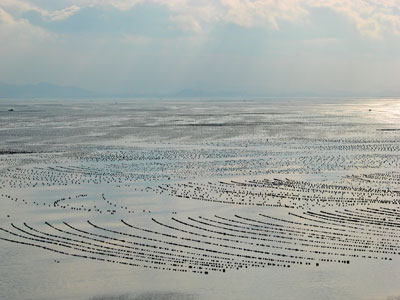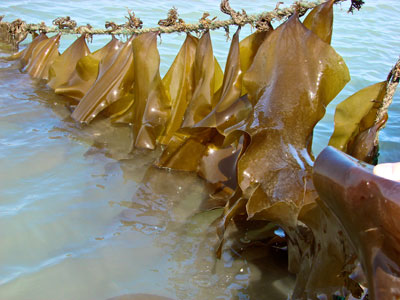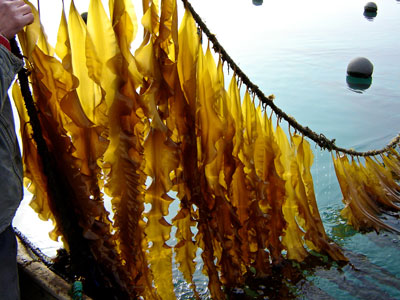Saccharina cultivation in China
Saccharina japonica (formerly Laminaria japonica) is the most important economic seaweed in China. Mariculture on artificial floating rafts started in 1952, apparently using plants from populations introduced accidentally from Japan), and production increased steadily until 1980 when the production of 200,000 dry tons (about 1,500,000 wet tons) were achieved. In the late 1980s, the cultivation area and total yield declined due to the development of shellfish culture as farmers preferred cultivating shellfish to kelp. Currently, the yield of kelp from about 200,000 acres of farms is about 250,000 dry tons from about 2,000,000 wet tons, worth about 2 billion Yuan (Dr Zi-Min Hu, pers. comm.).
Large cultivation bay in north-east China (photograph © Dr D.L.Duan;
courtesy Zi-Min Hu)
Culture of sporelings
The first step consists in the collection of the zoospores onto the seeding cords. To do this fronds with mature sporangial sori are subjected to partial drying in the air and then placed in a small container with seawater. The liberated zoospores readily attach themselves to the the seeding cords. The gametophytes and early sporophytes are cultured in water of 8–10°C in glasshouse for about three months, by which time the juvenile sporophytes are 2–3 cm in length.
Transplantation
When the water temperature has dropped to about 20°C, sporeling cords are removed from the glasshouse and on floating rafts. In a month or so, the sporelings will have grown to juveniles of 10–15 cm or longer. These juvenile sporophytes will be eventually brought to the transplanting room and placed in tanks filled with seawater. Due to their fast growth on the cords they are thinned. Plants are removed from the original sporeling cord and inserted in the twists of the kelp ropes, at a density of about 30 juveniles to each rope of 2 m.
Culture methods
There are two basic floating-raft kelp cultivation methods. One is the hanging-kelp rope (also called single-raft) cultivation method. The other is the horizontal kelp rope (also called double-raft) cultivation method. The floating line, is about 60 meters long floated at the surface by buoys generally made of glass or plastics and anchored terminally by anchoring lines to wooden pegs driven into the sea bottom. Each kelp rope has about 30 plants twisted in it and is about 2 m in length. In the single-raft method, the kelp ropes are hung down from floating line and weighted down by a small piece of stone. In the double-raft method, the two kelp ropes are linked or tied together at one end and the other ends tied to floating lines. The hanging kelp rope method has the advantage of better water movement but has the defect of uneven growth of kelps. The horizontal kelp rope method gives an even growth of kelp. However, it has the disadvantage of being more resistant to water motion. Generally, the single-raft method is better adapted to comparatively clearer water regions, and the double-raft method to turbid regions with lower water transparency, such as the Zhejiang coast.
Floats and harvesting boats in north-west China (photograph © Dr Wang Xialiang; courtesy Dr Zi-Min Hu)
Harvesting and processing
Harvesting takes place when the fronds are mature. The time for harvesting is important to kelp farmers. Since Saccharina is sold on the market on the basis of dry weight, and since the wet weight to dry weight ratio changes from month to month, the criterion for selecting harvest time must take into consideration the highest per-unit area production rate plus the lowest wet-to-dry ratio.
Saccharina japonica on ropes in north-west China (photograph © Dr Wang Xialiang; courtesy Dr Zi-Min Hu)
In harvesting Saccharina japonica, the kelp ropes are detached from the floating line, and collected in small boats, many of which are towed in a long line by a motor boat. When the boats reach the wharf or shore, the plants are transported to land and dried under the sun.
Saccharina japonica on ropes in north-west China (photograph © Dr D.L. Duan Delian; courtesy Zi-Min Hu)
Utilization and marketing
Most of the Laminaria japonica produced in China is used for food. Besides its role as a “health” vegetable, in China Laminaria is also important as raw material for its alginated, mannitol and iodine in a special program for the comprehensive utilization of Laminaria. Recently, the kelp produced in China has been employed in the processing of synthetic feed use in mariculture. Formerly the kelp was sold on the market only in its crude dried form, but recently small package of shredded and seasoned forms with different flavours have been introduced to the market and have been very well reveived by the Chinese people.
References
AlgaeBase with more photograph of Laminaria japonica morphology, cultivation and utilization (http://www.algaebase.org/search/species/detail/?species_id=129141)
Wang Feijiu 1988. Marine phytoculture in China. http://www.fao.org/docrep/field/003/AB719E/AB719E02.htm









